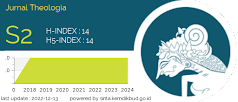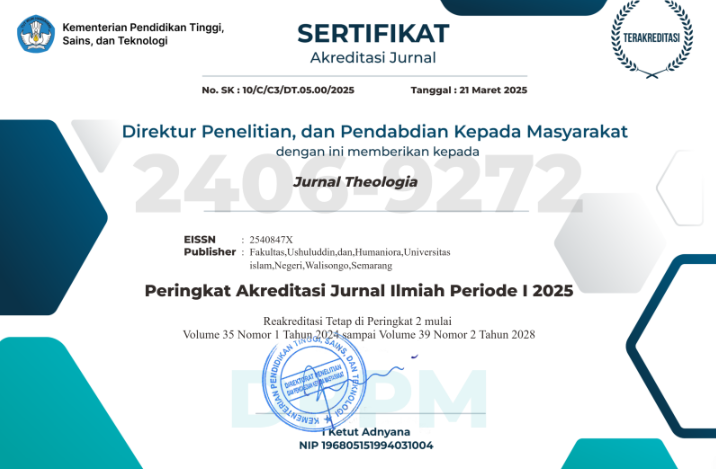Implementing The Spirit of Jihad in Sufism
DOI:
https://doi.org/10.21580/teo.2020.31.1.5379Keywords:
spirit, jihad, sufism, syaikhAbstract
This paper aims to illustrate that Sufism does not fully lead to scepticism and passivity in fighting for the benefit of Muslims. Sufism was originally a zuhud (ascetic) movement in Islam, and in its development, gave birth to the tradition of Islamic mysticism. Some Islamic thinkers argue that Sufism is an exile from the people who are more concerned with spiritual life so that they no longer think about the problems of Muslims. Sufism experts, as described the Sufis do not care about what is happening around them, let alone strive for the religion of Allah and also as defined by the public. This article is a literature study and uses the content analysis method from several documents about the history of Sufism. This paper proves that not all accusations about Sufism are true. It could see from the reality on the ground, and it turns out that the Sufis and their students play a lot of roles in helping the struggle of Muslims. Both in eradicating evil, re-implementing the Islamic Shari'a, abolishing polytheism, and Jihad. Jihad that has long been forgotten by Muslims in the late Ottoman period. The struggle of heroic Sufis will never fade from the pages of history. True Sufism is Sufism, which follows the instructions of Allah and His Messenger towards the cleanliness of the spirit, the glory of morals and manners, which finally knows Allah with bright eyes. The Holy Jihad is for the sake of perfection, Jihad against self, greed, against tyranny.
Downloads
References
Al-Kumayi, Sulaiman. “Konsep Sufisme ‘Shakhs-i Manevi Dan Hizmet’ Muhammad Fethullah Gülen.” Ulumuna 17, no. 2 (November 8, 2017): 359–86. https://doi.org/10.20414/ujis.v17i2.167.
Aractingi, Jean-Marc, and Christian Lochon. Islam et franc-maçonnerie: traditions ésotériques. Saint-Denis: Édilivre, 2014.
Banhul. Nasimal-Wahl Rus fi Kaukasus. Beirut: al-Amwaj, 2012.
Bashir, Shahzad. “Naqshband’s Lives: Sufi Hagiography between Manuscripts and Genre.” In Sufism in Central Asia, edited by Devin DeWeese and Jo-Ann Gross, 75–97. BRILL, 2018. https://doi.org/10.1163/ 9789004373075_004.
Er, Muhammad Emin. Laws of the Heart: An Introduction to the Spiritual Path in Islam, 2014.
Farid Bek al-Muhami, Muhammad. Tarikh al-Dawla al-’Aliyya al-’Uthmaniyya. Beirut: Dar al-Nafa’ is, 2009.
Fārūqī, ʻImādulḥasan Āzād. Sufism and Bhakti: Mawlānā Rūm and Śrī Rāmakrishṇa. 1st ed. New Delhi: Abhinav, 1984. https://search.lib. virginia.edu/catalog/u93280.
Feild, Reshad. The Last Barrier: A Journey into the Essence of Sufi Teachings. 25th-anniversary ed. Great Barrington, MA: Lindisfarne Books, 2002.
Glover, John. Sufism and Jihad in Modern Senegal: The Murid Order. Rochester Studies in African History and the Diaspora, v. 32. Rochester, NY: University of Rochester Press, 2007.
Gowins, Phillip. The Sovereign Soil: Sufism : A Path for Today. Boca Raton, FL: New Paradigm Books, 2006.
Hammad, Tazid Hammad. Ahkam Jihad wa Fadhailuh. Bairūt: Dar al-Wafa, 2011.
Hamzeh, A. Nizar, and R. Hrair Dekmejian. “A Sufi Response to Political Islamism: Al-Aḥbāsh of Lebanon.” International Journal of Middle East Studies 28, no. 2 (May 1996): 217–29. https://doi.org/10.1017/S0020743800063145.
Huda, Sokhi. “Karakter Historis Sufisme Pada Masa Klasik, Modern, Dan Kontemporer.” Teosofi: Jurnal Tasawuf Dan Pemikiran Islam 7, no. 1 (June 2, 2017): 64–95. https://doi.org/10.15642/teosofi.2017.7.1.64-95.
Husken, Thomas. Tribal Politics in the Borderland of Egypt and Libya. 1st edition. Palgrave Series in African Borderlands Studies 14666. New York, NY: Springer Science+Business Media, 2018.
ʻAẓīmī, K̲h̲vājah Shamsuddīn. Muraqaba: The Art and Science of Sufi Meditation. Houston, Tex.: Plato Pub., 2005.
Ibrahimi Afifi. Tasawuf Tsarwahar-Ruhiyah fi al-Islam. Beirut: Dar As-Sha’b li Taba’ah, 2015.
Jarbu’ah, Muhammad. Khuyul as-Syarq, n.d.
Kabbani, Muhammad Hisham. The Naqshbandi Sufi Tradition Guidebook of Daily Practices and Devotions. Washington, DC: Islamic Supreme Council of America, 2004.
Kepel, Gilles. Jihad: The Trail of Political Islam. Cambridge, Mass: Harvard University Press, 2002.
Marranci, Gabriele. Jihad Beyond Islam. Berg Publishers, 2006. https://doi.org/ 10.26530/OAPEN_390768.
Mbacké, Khadim, and John O. Hunwick. Sufism and Religious Brotherhoods in Senegal. Princeton, NJ: Markus Wiener Publishers, 2005.
Meirison, Meirison. “Islamic Tolerance on Religious Freedom, Culture and Thought in Andalusia.” HIKMATUNA; Vol 6 No 1 (2020): HIKMATUNA: Journal for Integrative Islamic Studies, Juni 2020 DOI - 10.28918/Hikmatuna.V6i1.2313, June 16, 2020. http://e-journal.iainpekalongan.ac.id/index.php/hikmatuna/article/view/2313.
Melchert, Christopher. Before Sufism: Early Islamic Renunciant Piety. De Gruyter, 2020. https://doi.org/10.1515/9783110617962.
Naisaburi, Qusyairi. RisalahQusyairi fi Ilm al-Tasawuf. Kairo: Dar al-Hadits, 1999.
Nawawī, Yaḥyā Ibn-Šaraf an-. Riyadh al-Salihin of Imam [Jaḥjā Ibn-Šaraf al- Nawawi: Gardens of the Righteous. London: Curzon [usw.], 1975.
Neale, Harry S. “The Concept of Spiritual Jihad in Learned Sufi Texts.” In Jihad in Premodern Sufi Writings, by Harry S Neale, 47–56. New York: Palgrave Macmillan US, 2017. https://doi.org/10.1057/978-1-137-56155-8_4.
Nūrbakhsh, Javād. Sufism I: Meaning Knolwdge and Unity. London: Khaniqahi-Nimatullahi, 1993.
Qalali, SaljukQalali. Suqur al-Quqas. Bairūt: Dar al-Qamari, 2011.
Raghib, Raghib Sahabi. Qisah al-Andalus min al-Futuh ila al-Suqut. Rabath: Muasasah Iqra’, 2014.
Saib bin Ali al-Qahtani, Saib bin Ali al-Qahtani. Al-Jihad fi Sabilillah. Beirut: Dar al-Qalam, 2016.
Schimmel, Annemarie. Mystical Dimensions of Islam. Chapel Hill: University of North Carolina Press, 1975.
Sells, Michael Anthony, ed. Early Islamic Mysticism: Sufi, Qurʼan, Miraj, Poetic, and Theological Writings. The Classics of Western Spirituality, #86. New York: Paulist Press, 1996.
Stoddart, William, and Reynold Alleyne Nicholson, eds. Sūfīsm: The Mystical Doctrines and the Idea of Personality. The Masterpiece of Sufism 1. Delhi: Adam, 1998.
Suwayrī, Sārah. Al-Ṣūfīyah fī al-Islām: Anthūlūjīyā. Al-Ṭabʻah al-Ūlá. Bayrūt: Manshūrāt al-Jamal, 2016.
Zürcher, Erik Jan, ed. Jihad and Islam in World War I: Studies on the Ottoman Jihad on the Centenary of Snouck Hurgronje’s “Holy War Made in Germany.” Debates on Islam and Society. Leiden: Leiden University Press, 2016.
ابن هجر العسقلاني، أحمد بن علي،, براك، عبد الرحمن بن ناصر, and فاريابي، نظر محمد. فتح الباري بشرح صحيح البخاري. al-Riyad: Dar al-Tibah, 2011.




















